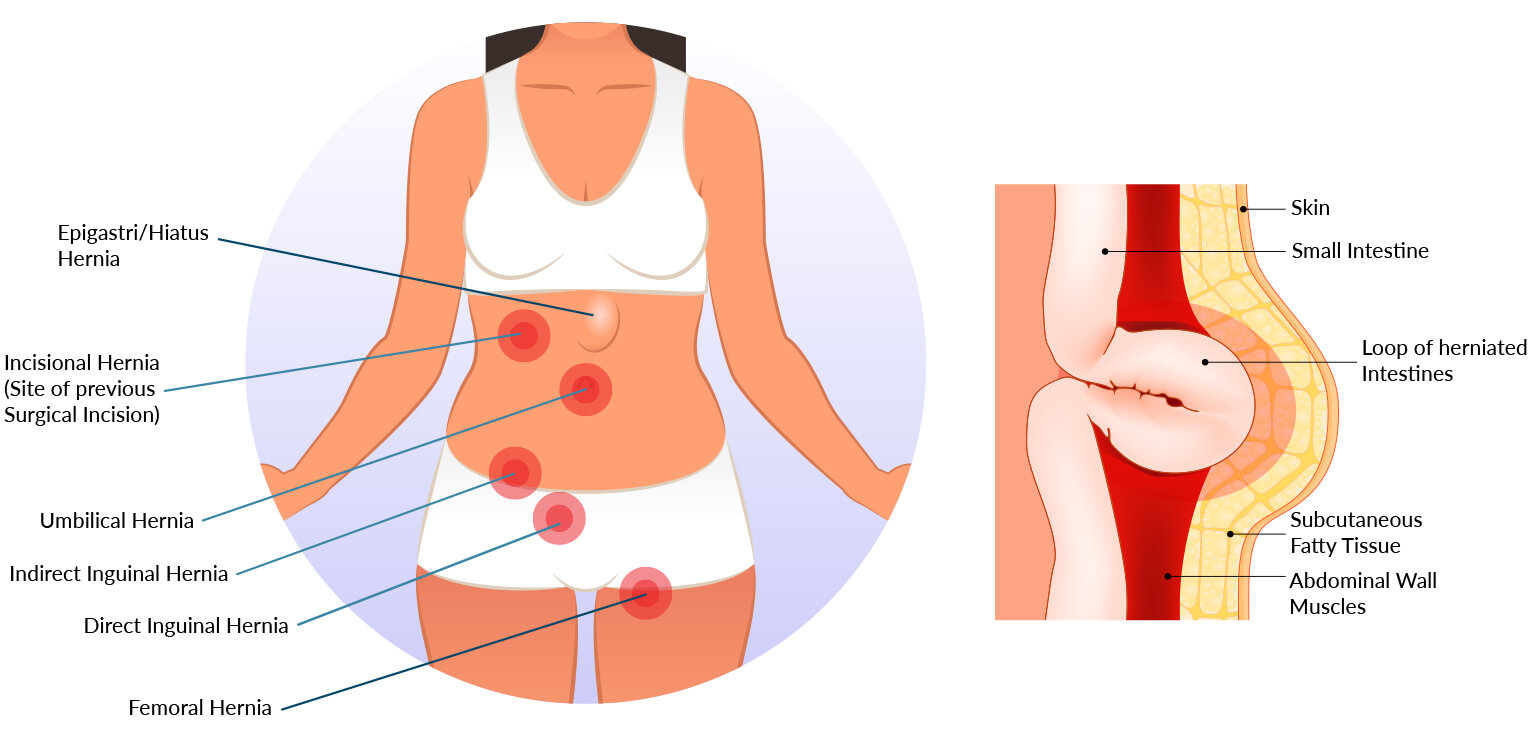Abdominal Wall Hernia Surgery
Types of Abdominal Hernias
What is an abdominal wall hernia?
An abdominal wall hernia occurs when a weak spot in the surrounding muscle of your abdominal wall allows fatty tissue or a portion of internal organ to squeeze through. A hernia can appear as a bulge causing pain and other potential complications. A hernia will not go away or get better over time, but it can enlarge. It can lead to serious problems – and possibly require emergency surgery – if left untreated.
What are the symptoms of a hernia?
A hernia is usually first noticed as a bulge under your skin, and it may cause no discomfort at all.
You may feel pain when you lift heavy objects, cough, strain during urination or bowel movements or with prolonged standing or sitting.
Pain or discomfort may be felt as a sharp or a dull ache.
Continuous pain or discomfort, overlying skin redness, nausea or vomiting are signs that the hernia may be strangulated.
A strangulated hernia with these symptoms is an emergency and needs immediate medical care.
What causes a hernia?
All hernias are caused by a combination of higher than usual pressure and an opening or weakness of muscle or ‘fascia’ of the abdominal wall. Anyone can get a hernia at any age, but they become more common as we get older. Other factors that may increase the likelihood of a hernia include:
Frequent heavy straining or lifting heavy objects without stabilising the abdominal muscles
Persistent coughing or sneezing
Aging tissues
Chronic constipation
Obesity, poor nutrition or smoking
Trauma, injury or abdominal surgery - an incision in your abdominal wall can create an area of potential weakness in your abdominal wall, although a hernia may not become apparent until years later
Following an infection at that site
Are there different types of hernia?
Incisional Hernia: An incision in your abdominal wall can create an area of potential weakness where the intestine pushes through the abdominal wall at the surgical site. Incisional hernias are common and can occur after any abdominal surgery including key-hole, but they most commonly occur after open surgery. The chances of getting one increase with age and obesity or if an infection occurs in the wound during healing.
Inguinal Hernia: This is the most common type of groin hernia. It forms due to a weakness in the lower abdominal wall into the inguinal canal in the groin. These are most common in men due to a natural weakness in this area.
Femoral Hernia: a less common type of groin hernia that is more common in women than men, especially those who are pregnant or obese, and occurs at adjacent to the femoral artery at the top of the upper thigh.
Umbilical Hernia: Occurs near the navel/belly button and are common in newborns, obese people or women who have had multiple children.
Hiatus Hernia: When the upper stomach squeezes through an opening in the diaphragm through which the oesophagus passes called the hiatus, resulting in the stomach being within the chest cavity instead of its normal position in the abdomen. This is an internal hernia, rather than an abdominal wall hernia and can have a variety of gastro-intestinal symptoms.
What is involved in hernia surgery?
Abdominal wall hernia surgery is performed under a general anaesthetic either through an open incision in the abdominal wall or using keyhole or laparoscopic surgery.
In some cases, Dr Ghadiri may be able to repair the natural muscle and abdominal wall tissue by sewing the tissues back together. However, to achieve lasting closure of the damaged tissue, a thin mesh is often placed on the abdominal wall for additional buttressing. There are a variety of mesh materials to choose from, including biologic or synthetic material; some are permanent others dissolve away. Dr Ghadiri will always discuss the options for each type of hernia and choose the type of repair and mesh that is best suited to your condition.
What are the advantages of laparoscopic hernia repair?
Where it is technically feasible laparoscopic hernia repair is the preferred method as it is less invasive and allows for faster recovery times. Other benefits include:
Less post-operative pain
Shortened hospital stay
Faster return to regular diet
Quicker return to normal activity
Less wound infections
Dr Ghadiri will discuss with you whether keyhole surgery is possible and advantageous for your particular hernia.
How long is the recovery after abdominal wall hernia surgery?
Most small hernia operations, such as groin or umbilical hernias repairs are performed as an outpatient, which means you go home on the same day. More complex or recurrent hernia operations may require you to spend 1-2 days in hospital after surgery.
Most people will be able to return to activities of daily living by one week post-op. However to allow complete integration of mesh into your tissues and hence the strongest repair with the lowest chance of recurrence, it is advisable that you avoid heavy-lifting or straining for four to six weeks post-hernia repair. These are general guideline and Dr Ghadiri will give you advice more specific to your hernia repair prior to discharge from hospital.
Activities to avoid in the immediate post-op period include:
Driving – for ten days
Heavy-lifting – nothing greater than 5kg for four to six weeks
Constipation – take regular aperients if necessary
Abdominal straining – return to exercise in a graduated manner, starting with walking/running/swimming after ten days and once wounds have healed and progressively increasing intensity. Weight-lifting and abdominal exercises should be avoided for six weeks.

